#UK Rail Tours
Explore tagged Tumblr posts
Text
...of Anoraks, Pufferküsser and Tragics!
A short foreword and explanation: My friend Michael in London has been doing a blog since blogs became a thing. He started out to review, comment on and complain about all things Apple. Hence the blog’s URL: www.macfilos.com. However over the years his obsession with photography and cameras, in particular Leica equipment, became the main focus of his blog. The blog name stayed the same, but it is…
#American 4-4-0#Beecham#Black 5#British Heritage Railways#Flying Scotsman#Great Central Railway#Great Western Mainline#GWR#Isambard Kingdom Brunel#Jacobite Steam Train#Leica#LNER#London Midland Scottish#London Victoria Station#National Railway Museum York#New Freedom#Norfolk and Western#North Norfolk Railway#North Yorkshire Moors Railway#O. Winston Link#Roanoke#Seattle and Carlisle Rail Line#Severn Valley Railway#Sherbourne Christmas Express#Southern Railway (US)#Steam Locomotives#Train Spotters#UK Rail Tours#UK Railtours#Virginia
0 notes
Text
Better as team - Pre Squid game!Choi Su-Bong/Thanos x reader


Summary: In Thanos fashion of being different, he managed to pull one of the biggest rappers in America and UK, despite his very odd and unhinged behavior, upcoming singer/rapper Y/n has no issue sharing the spotlight with her boyfriend
Warnings: None really other than Thanos's drug use, just some funny sweet pre games! Thanos! <3
A/n: So I had to take a different approach because Thanos doesn't really have any songs by the character, so I took a route with some of T.O.P's music, making Nam-Gyu this universe's G-dragon for some songs, so let me know what you think <3
Long distance was hard, especially whenever your fiancée lived in Korea currently, even if you moved everything of yours in his house, you were still forced to be in America or part of the United kingdom most of the time touring, recording, or filming. You never knew how to fix it until Su-Bong decided to step into the rap game himself, you were happy to support him, even collaborating with him on a lot of your songs, even if it was just back-up vocals.
Your fans were quick to fall in love with Thanos in the same way you did, but they didn't see the sweet vulnerable of him, only a few thousand of your friends saw the true Thanos, and that was at his first show with you.
As the giant props slid open revealing you and Thanos you were immediately shocked by how loud the screaming truly was, You jumped off the platform, starting to sing along with the track that played in your ear piece, as you heard Thanos rap his verse, you noticed he was still on the platform, holding onto the railing tightly. The entire show Thanos was glued to you on stage, either holding your hand, or just being near you. The more you preformed though, the more Su-bong found his groove on stage, allowing you both to have a lot more freedom and fun on stage as you sung with him.
You had just released your first single for the year, it wasn't your best work, but your fans seemed to like it a lot, including your fiancée. So as you preformed it on stage, following your choreography that you practiced hours beforehand, You shoved your finger to Thanos's chest as you rapped your verse, once you ended it and the instrumental played for a moment you walked away, pointing towards the camera blowing it a kiss before Thanos quickly picking you up running down to the end of the stage smiling "No! Thanos!" You shouted holding onto him "Take care of my girl!" He shouted before gently handing you over to crowd surf, you squealed, nervous about falling and being swarmed, Thanos watched closely as he starting rapping his verse, following you along on the stage "Alright give me her back! You're gonna hurt her!" Thanos jokingly shouted reaching out into the crowd, you thanked everybody as they helped you over the barrier, back on stage.
Once Thanos started making his own singles, it made everything a new type of fun. He had multiple, Doom Dada, Turn it up, Knock out, and Zutter, some that you'd occasionally have verses in, others were solely Thanos, others he had his friend sing with him, and you couldn't be more proud of him. As you stood on the platform you smiled at your fiancée watching him rap, with his friend, hearing the familiar lyrics to Zutter you swayed your hips to Su-Bong's, as much as he annoyed you, he was always hot on stage, his bad boy act he did was always adorable. As he continued moving his hand along with his words he made his way to you, bringing you over with him to the center of the stage, basically using you as his back up dancer, you laughed at him glancing at his friend who just laughing sticking his tongue out to motion he had taken his stupid cross necklace with him to the concert. As you held his hand you mimicked the dancer who was a few feet in front of you with Nam-Gyu, bending at the waist and swaying your hips, Thanos just smirked, it making him even cockier if ever possible. As you spun around to get in line with the others to blend out of the dance, Thanos just pulled you close to him as he squatted down to rap to some of the girls up front against the barricades. You wanted to strangle him, but instead just continued until the song ended, Nam-Gyu going backstage while his next single came on, you walked around, purposely trying to match the moves your chorographers showed you to 'compliment' each other during verses and songs.
As you finished your show, you felt as if you were going to pass out, saving your most upbeat songs for the very end was a mistake, You laid on the stage floor, the curtain had been closed for awhile, the fans all funneled out not long ago, but the floor was so cool against your face "Sunflower, What're you doing on the floor?" Thanos asked approaching you with your coat "I'm so hot, and so tired" You groaned, not wanting to move yet, Thanos just sighed pulling you to your feet raising his eyebrows as your head fell back in exhaustion "I wanna go home" You groaned smacking his side playfully, he just laughed wrapping your coat around your shoulders along with his arm, leading you out to the tour bus "Come on, we can sleep in here, until we get to the hotel" He offered shutting and locking the door after you walked in, you nodded, crawling into the bed placed in the back of the tour bus, Su-bong not far behind.
Your California shows were even more exhilarating, because of your and your boyfriend's hometowns, your guy's music reached to all different areas of the world, making you both known internationally. As you stood on the stage you stood in shock at how huge the arena was "I think this might be our biggest show, Baby" You stated noticing your purple haired boyfriend making his way to the stage floor "Holy shit!" He shouted, spinning around, his little rapper heart exploding at just the size of the place, not to mention that you were sold out, so they were all there for you and him. You smiled walking over to him giggling "We still have mic check" You reminded, he just turned pulling you closer to his body "This is fucking amazing" He whispered pressing his lips to yours, you happily kissed back, never noticing your other band mate walking out "Holy shit, guys!" Nam-Gyu shouted before noticing the both of you "Guys! We have mic check! Not mouth check!" He groaned, going to grab all the microphones from the stage manager.
The show is crazy for you at least, everybody was screaming and singing along, the vibes between the three of you on stage was perfect, everything was going right and you could tell it made the three of you even more pumped. As you jumped around singing along with Thanos to your shared song 'high high', you weren't very open about your sex life, but you had a character to play on stage, using your bisexuality show mainly in your songs. As you got to the chorus you had to hold back a laugh watching Nam-Gyu jump onto Thanos's back as he sang with his friend, Smirking making your way to the edge of the stage, offering your hands to your fans as the boys continued singing. As the show continued you stopped for a moment to breathe "You guys wanna hear my favorite song?" You asked teasingly into your microphone, the crowd screamed loudly in response, Your fiancée's eyes snapping over to yours "Only if Y/n does the chorography right" He replied, his voice deep as he looked up to you through his lashes, you rolled your eyes going to your marker as Knock out started to blare through the speakers. You moved with both boys as they sung, you microphone sitting with your stage manager so you wouldn't risk dropping it. You giggled a bit as you shifted to the left and right quickly with the beat of the music, watching Nam-Gyu make his way to the end of the stage with his verse, as Thanos started up he kept eye contact with you, going along with the track in his ear. You weren't sure what to do for a moment, seeing him going off the dance you rehearsed was confusing, but you quickly got back into it as Nam-gyu made his way back over, following his rehearsed part at least. You kept eye contact as you swayed your hips to your fiancée's verse, Nam-Gyu holding your hand in the air as his hand ghosted over your hips, that was one thing you loved about your fellow bandmate, no matter how much he tried to get with you whenever you first met, he was always respectful of you and your relationship while preforming.
You moved away as the boys moved closer together to sing the end chorus together, as the music cut out, it was replaced by screams, you spun around excitedly before walking between the two smiling before looking at Thanos "You like, baby?" He asked into his mic before the lights cut out and the platform on the stage started to close so you were hidden by the props again. "That was amazing!!" You squealed loudly, Thanos just shook his head laughing before bringing his microphone up "You're still on" He whispered, you gasped, your cheeks heating up in a bright red blush, flipping the switches off and handing it to your manager you hugged both boys tightly "I swear that was our best show yet!" Nam-Gyu shouted excitedly, you nodded in agreement as Thanos kept his arms around you "How about, we go..out and party? As celebration?" He offered, you glanced at Nam-Gyu before you both agreed, making your way to the dressing rooms to change.
After your last show in California, you felt like the three of you just bounced off of each other perfectly, your management even making a statement by getting you a shared house to stay in during breaks from tour. Rushing down the stairs to said home you huffed "Boys! We have promo pictures in an hour! Why aren't you ready!?" You shouted in shock, both boys turned their heads to look at you "We are ready, you're just...overdressed" Thanos offered staring at your baggy jeans and tight as hell tanktop, one of his oversized button ups as a cover-up, one sleeve sitting at your elbow, the other sitting on your shoulder "No, I am dressed for our promo and album cover photoshoot!" You whined, they were starting to piss you off, they had known about this for weeks leading up to it, so why weren't they taking it seriously.
After a very long stare down between your bandmates, they rushed upstairs to change before meeting you outside in the car, apologizing to your driver for the wait, you were on your way to the shoot. You wished you could say it got easier after that, but it didn't, the boys pulling off their own poses they wanted, rather than what the photographer and PR team wanted. As you approached the scene, you manager gave you a pleading look, without the need of saying anything you already understood, they were high and not listening to instructions. "Boys! Let's wrap this up!" You demanded before walking to them, standing on your marker, listening carefully as the photographer told you how to stand with both men. As you stood proudly between them, you sighed as they were still talking behind you about what stunt they should try next at the next show, you turned around, the photographer expecting you to shout, but instead you just gently took both men's hands placing them on your shoulders "Now, shut up please, and look pretty" You stated looking at the camera lenses, your manager just laughed shaking her head "That's y/n, both boys listen to her like a scripture" She whispered to the team behind the cameras, you didn't have much issues after that, the tension quickly fading whenever you got on set with the boys.
While you weren't sure how any of this would end in the future, you were all three sure of one thing, you all worked better as a team, the boys giving you the confidence you need to preform live, and you keeping the boys in line and sane whenever it came to literally anything.
--
You like?
--
Taglist!!
@acehasmyheart
@private-vampire
@ag022123
@corrdelia
#squid game thanos#thanos x reader#squid game#squidgame#top x reader#choi su bong x reader#choi seunghyun#thanos squid game#t.o.p#t.o.p x reader
187 notes
·
View notes
Text
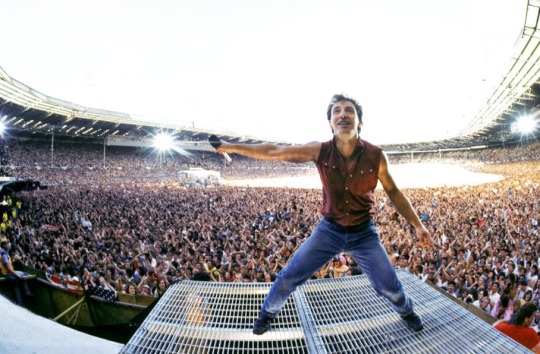
"In 1985 I was touring with Bruce Springsteen, who was playing a series of dates in the UK. The shows were mammoth, both physically and in length, running three hours plus. By the time we hit Wembley Stadium in London, I'd hit a creative wall and was trying to come up with an idea that would bring a different look to what I'd been shooting - something, anything, out of the norm. [...]
"I knew from previous shows that Bruce would always go out to the pod at stage right at the exact same point in every show during (if memory serves) "Hungry Heart,” which was the third or fourth song after the intermission. During the break I clamped a Nikon onto the rear railing of the pod stage, with a full frame fisheye lens looking out towards the crowd, and a 10 foot long remote cable hanging underneath the small stage so I could fire the camera from directly underneath Bruce - who wouldn't be able to see me. Of course, I wouldn't be able to see him either, so I needed to talk to him first to prep him on the shot. I pre-focused the camera, set the exposure and made a beeline for Bruce's dressing room. "I know you've got a few things on your mind," I said, "but I've mounted a remote camera on the rear railing of the pod on stage right. You'll barely notice it, but if there is any way that when you're out there you could turn around and play to the back of the house, I think I can get a great shot of you with all of Wembley Stadium in the background - but I really wanna see your face in the shot, so that's why I'll really need you to have your back to the audience." Bruce let me run through my whole speech without saying anything or showing one bit of interest. Then just before I turned to leave he suddenly said, "Yeah, I think it's ok.” I was stunned. I was thrilled that he'd said yes but I thought there is no way in hell Bruce is gonna remember. Like I said, the guy had a lot more important things to think about than my little set-up.
"When the time came I stood underneath the stage with my remote trigger dangling in my hand. I couldn't really see what was happening above me but through the slats in the wooden runway I suddenly saw a pair of black boots running to the spot directly on top of me. I took a deep breath, counted to 10 and kept the button pressed on the remote cable, firing off 36 straight frames. This was gonna be a hit-or-miss situation, no two ways about it. After Bruce finished the show I ran over to the Nikon and made sure that the camera had even fired - and it had. I pocketed the roll of film until I got it to the lab the next day.
"I got everything wanted, and more. Bruce had followed my directions perfectly, and for most of the roll he had faced the back of the house, which was empty because they hadn't sold those seats. He had essentially mugged for my camera with his back to the audience, dancing the exact same way he always did during that song. The crowd must have thought he was crazy but he really came through for me. We ended up with a truly memorable shot that could never have been made without his willingness to just go for it and trust my instincts."
- Neal Preston, Exhilarated and Exhausted
#photography#bruce springsteen#neal preston#long post#hey look what happens when you trust your photographer#if only everyone felt this way
44 notes
·
View notes
Text
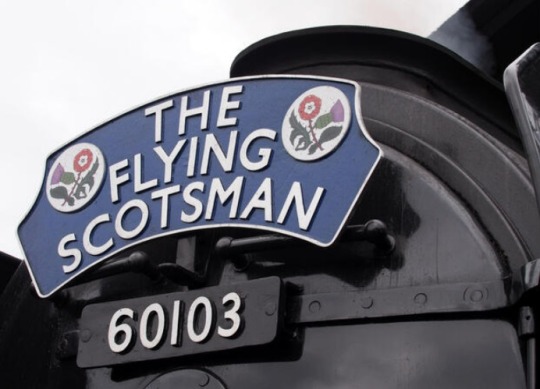
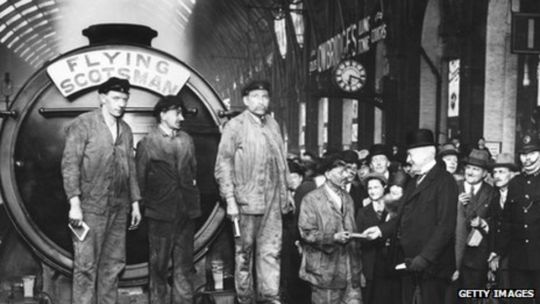
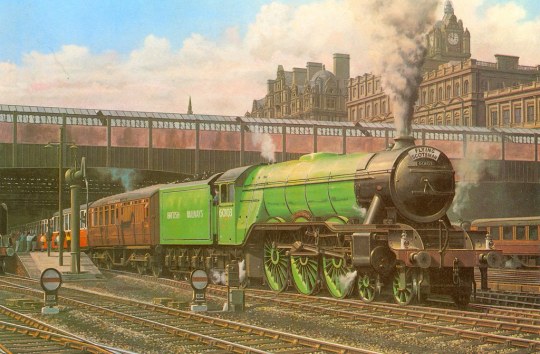

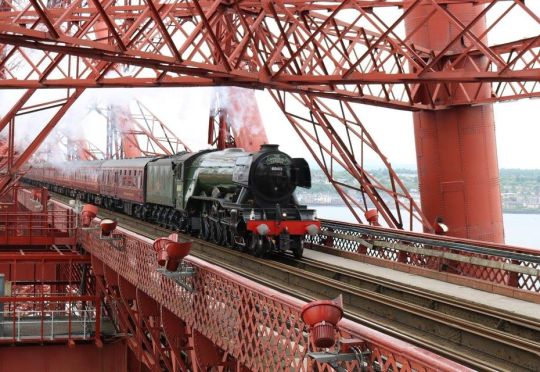
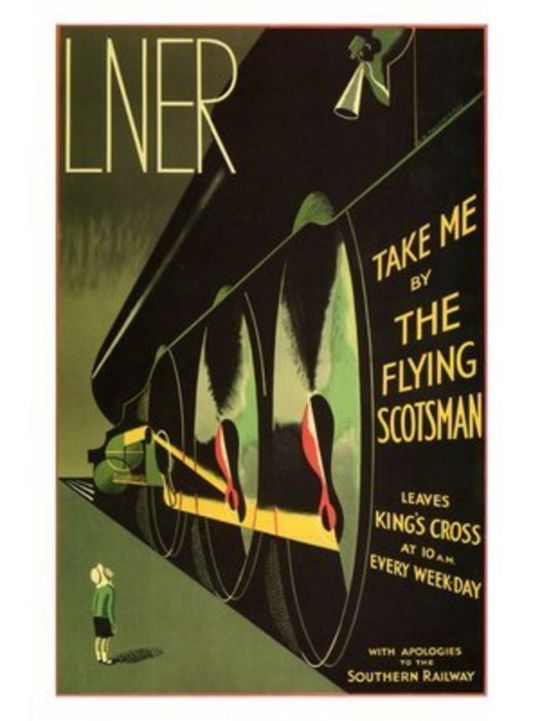
On 24th February 1923, the world famous steam train, the Flying Scotsman, went into service.
From the 1920s the train was considered the height of luxury. Onboard there were first-class restaurant facilities, a cocktail bar and radio equipment, so passengers could hear the horse-racing results.
There was even a hairdressing salon where men could have their facial hair shaved with an open razor, made possible because the barber's chair was set in such a position that there would be "no jolting". I'm not sure I would have a shave in a moving train!
The train's hairdresser was reportedly known as "Sweeney Todd of the Rails", given his precarious trade.
In 1928 the train broke the record for the longest regular non-stop train journey in the world, when the LNER ran an express service for the entire 393-mile route.
This record would last until 1948, when, unintentionally, the train broke its own record. The Flying Scotsman ran for 408 and a half miles in May of that year when flood damage to the main line caused diversions via St Boswells and Kelso.
Throughout World War II The Flying Scotsman was one of the few titled trains that continued to operate along the East Coast - it carried troops between London and Scotland, although the headboards and roofboards were removed for security.
And, on 21st June 1958, in a historic move which would signal the decline of steam, The Flying Scotsman was hauled for the first time by a diesel locomotive.
The service is currently run by government-owned East Coast.
In May 2011 they relaunched the service, painting one of their locomotives, the Class 91 No. 91101 with Flying Scotsman branding.
At the launch East Coast said the move was "part of our policy of bringing back train names and restoring pride, passion and even a touch of glamour and romance back to the East Coast railway".
It's not all a romantic journey though, just last September there was, what the called a "slow speed” crash with another heritage train hours before visitors were due to board it.
It happened lwhen the ocomotive was being shunted into place to be coupled with the Royal Scotsman train carriages, which were stationary.
A spokesman for Royal Scotsman train owner Belmond described the collision as “minor” and said there had been no major injuries.
"We are grateful for the prompt attendance by paramedics who were on site to assist the few passengers and team members who sustained minor injuries,” the spokesman said.
"One passenger and one team member are attending hospital for a precautionary check-up.
"All passengers have been transferred to a hotel where our team is on standby to offer support and to assist with our guests’ onward travel arrangements."
Last year ater travelling 10,000 miles across the UK as part of its centenary celebrations, world famous locomotive Flying Scotsman will spend the first part of 2024 on static display at the National Railway Museum in York before resuming rail tours later in the year.
The custodianship of The Flying Scotsman is up for tender later this year, so by this time next year I may be telling you about new "owners"
98 notes
·
View notes
Text

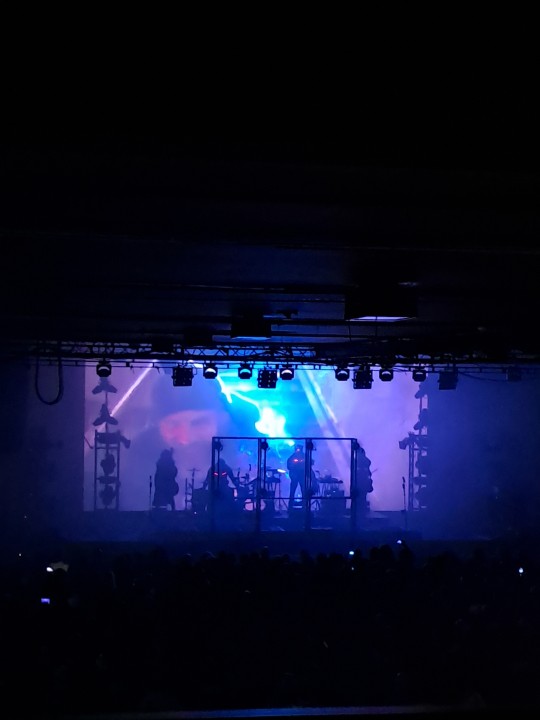
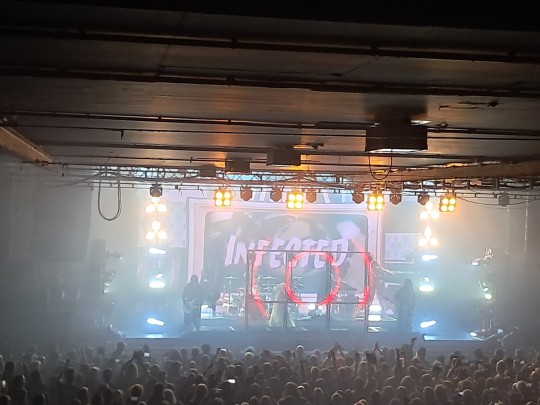

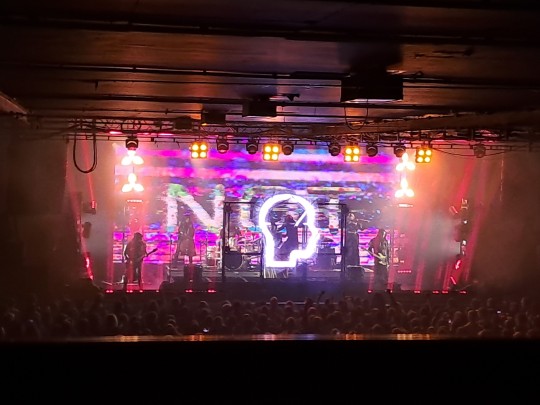
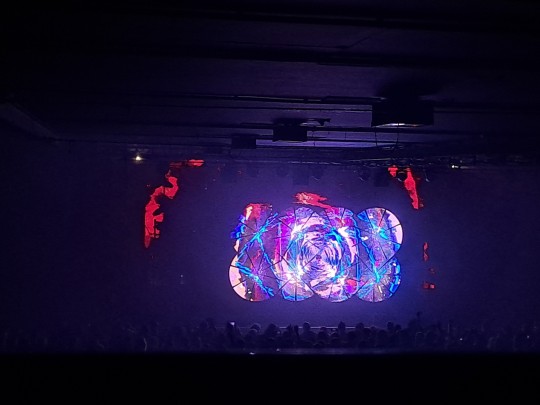
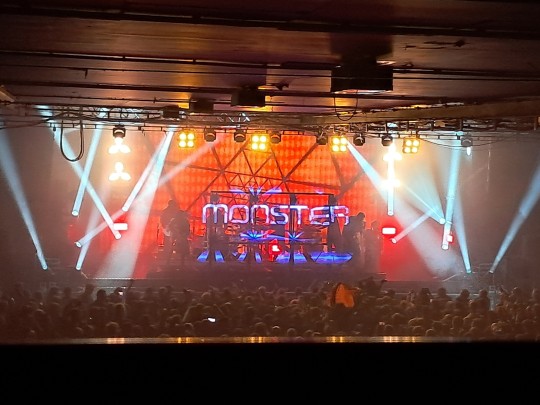
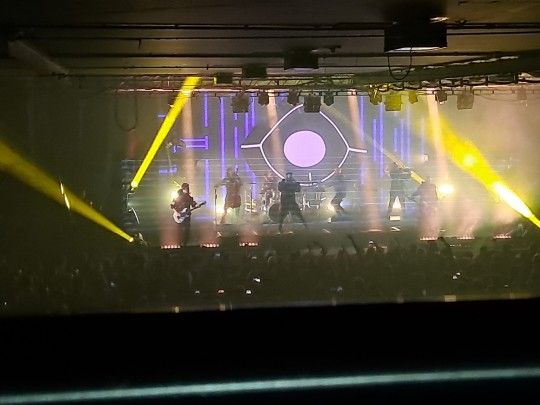
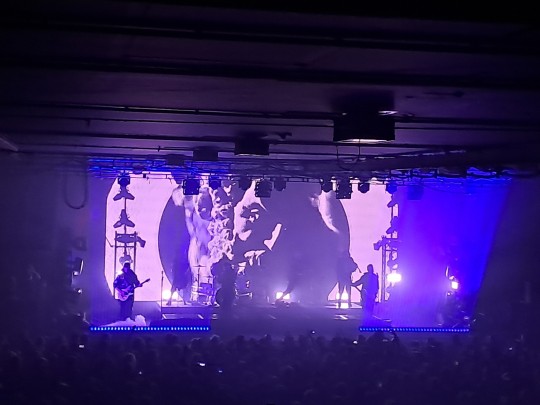
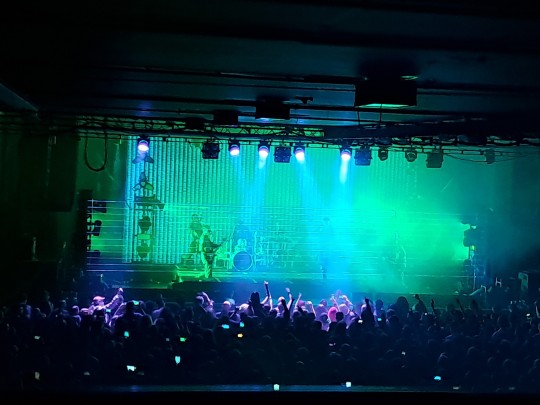
BACK FROM STARSET, OH MY GODDDD THEY WERE SO FUCKING GOOD!!! Dustin was absolutely not kidding when he said they'd return bigger and better, holy fucking shit. This time they were in Academy 1 which is a lot bigger venue!
They had no support act, because most of the stage was taken up with this amazing, huge and elaborate series of spinning blades that projected holographic shit??? It was honestly beautiful and sooo intricate, and all the images were woven in with the music and the narrative videos in between which told the story of a guy escaping the whole New East/New West dystopia and it was all leading in to the setup for the new album which I'm taking to be HUMANITY GOING TO MARS??? HELLO!!!
I got terrible photos cos Academy 1 means no close up accessibility, so we were on a frankly not great balcony (the metal railing topping the barrier was literally directly in my line of sight so I had to sit real forward and up on my chair so now my thighs are KILLING ME but it was so fucking worth it) and very far away, but being high up was nice!
They absolutely killed it, played some songs I haven't seen live before INCLUDING all three new songs (and Waiting on the Sky to Change!!)!! My screams when they started up with Brave New World haha, I went absolutely mental. Songs like that make me a little sad and wistful tho, cos I wish I was down there in the pit moshing but now I have to be satisfied with chair moshing, which honestly gets... Very Vigorous lol, I get very uh. Bouncy XD
Anyway, I cannot recommend Starset enough to see live, their shows are always stellar and they're honestly getting better and better every tour!! Absolutely worth it if you get chance, we've seen them every UK visit since they started coming here and I feel like I'll want to continue seeing them for eternity tbh!!
21 notes
·
View notes
Text
A History of Six Chaos: West End 5.0 (2023-25)

The West End 5.0 production started with chaos immediately due to principal Seymour Kayleigh McKnight being unable to perform for the first few weeks of the production, so alt Gabriella Stylianou was made temporary principal until Kayleigh's return. Soon after, universal swing Natalie Pilkington left briefly and was temporarily replaced by former tour swing Harriet Caplan-Dean. During this time, former swing Esme Rothero returned for two emergency cover Seymour shows December 13th and 15th 2023.
In the new year, former tour alternate Leesa Tulley performed a total of 13 emergency cover shows: Howard on February 23rd, March 17th, and April 4th; Parr on March 31st and April 6th; and Seymour on June 2nd 2x, 8th 2x, 14th, 16th 2x, and 18th. If Leesa wasn’t already cast in the new Marlow and Moss musical, it seems likely she would have formally joined the production, but after this point she was in rehearsals and no longer able to act as the de facto emergency cover.
After this, things truly went off the rails. Kayleigh McKnight had to leave the production, principal Howard Inez Budd was on an extended leave, and Natalie Pilkington‘s universal swing contract ended. Two former alternates, Danielle Rose from the West End 3.0 and 4.0 casts and Hana Stewart from 2.0, returned to the production, Danielle as B/S/H alt and Hana as a swing (despite only Danielle having hit Swingo during her run). Hana surprisingly wore her original costume from 2019. In the single performance between Natalie leaving and Hana and Danielle joining, alternate Tamara Morgan was brought in from the UK tour as an e/c for Parr on June 25th 2024.
Despite the added coverage, the West End almost immediately needed to cancel three performances, one on the 29th and two on the 30th. One show did run on the 29th with former principal Seymour Claudia Kariuki (who was an ensemble member in Sister Act at the time) as an emergency cover. A month later, tour alt Ellie Jane Grant was brought in to emergency cover Parr for two shows on July 21st and and then Cleves on August 20th. Harriet Watson then came back once again for two Parr emergency cover shows on August 30th and September 6th, after which Caitlin Tipping was brought on as the new principal Seymour and Danielle Rose left the show, although Danielle was back soon after for one more emergency cover Seymour show on 9/29. Hana left the show at the beginning of October, replaced by Ellie as the new second swing.
Even with a second swing and a full principal cast, the production still couldn’t catch a break. Hana Stewart returned for one more Seymour emergency cover on October 26th, followed by former tour Seymour Erin Caldwell on the 29th. Esme Rothero was then hired as a third swing in mid-November, which provided additional coverage but did result in the first triple-silver-costume show where all three performers were wearing the exact same version of the costume, with Gabriella in her second cover Parr, Esme as Howard, and swing Meg Dixon-Brasil as Boleyn. Esme left the production in early January to provide additional coverage to the UK tour during their Japan stop.
With only a month left to go, the most chaotic Six production to date couldn’t end without one more burst of emergency covers. On January 19th 2025, three emergency covers performed a total of five times- Shakira Simpson and Rachel Rawlinson as Boleyn and Parr respectively for both shows, and (of course) Harriet Watson joined as Cleves for the evening show. Rachel had last performed with Six in October of 2023, so it’s wildly impressive she was able to join the show with little notice over a year later. This also marked the first time a cast has hit emergency cover Swingo- having an emergency cover for all six roles. To ensure that this cast would break ALL the chaos records, Harriet returned for one more emergency cover show, this time as Boleyn, on the 26th.
Stats: # total shows: 591 # emergency cover performances: 31 # emergency performers needed: 11 (Esme Rothero, Leesa Tulley, Tamara Morgan, Claudia Kariuki, Ellie Jane Grant, Harriet Watson, Danielle Rose, Hana Stewart, Erin Caldwell, Shakira Simpson, Rachel Rawlinson) # shows canceled: 3 # alts/swings: 3 alts, 1 swing # temporary/short term performers: 6 (Natalie Pilkington as universal swing, Harriet Caplan-Dean as temp swing, Danielle Rose as temp alt, Hana Stewart as temp swing, Ellie Jane Grant as temp swing, Esme Rothero as temp swing) # cast member changes: 1 (Kayleigh McKnight replaced by Caitlin Tipping as principal Seymour)
Overall chaos score: 10/10 nothing is topping this
17 notes
·
View notes
Text
Saviour II X Andy Biersack- Part 3
Masterlist
(Sequel to Ribcage)
Andy and Delia had finally found their happy ending in each other, Delia was living in LA with Andy and things could not be better.
With the group reuniting to complete a UK and Europe tour, some challenges threaten to tear Andy and Delia apart. Can Andy continue to try his hardest to be what Delia made, or will the couple drift apart from each other?

"Okay let's just run through the intro of Faithless so I can match up the backing sound of the bells." Delia explains through her mic that was connected to the in ear pieces of the band, this earning her a thumbs up from the band.
"Hey D, just so you know, Juliet has just arrived at the venue." Shevy informs her as she walks into the sound tech booth of the venue "You feeling okay about her being here?"
"Yeah. I mean I don't know her only about her." Delia explains as she fiddles with the switches of the sound board "I'm not her biggest fan after how she damaged Andy, but it's Andy I'm worried about not myself."
"Funny, I feel like Andy would say he's worried she'll get to you." Shevy laughs awkwardly "You and Andy just need to look out for each other. I hoping she won't do anything, but with how Juliet was I'm worried for you both."
"I appreciate it Shevy, but Juliet is the least of my concerns and you know that." Delia sighs as she watches Andy sing his heart out on the stage.
"Yeah, of course." Shevy nods as the band finish the song "I think you should tell them she's here so they know."
"Good idea." Delia nods before pressing the button to turn on her mic "Guys, Juliet has arrived in the venue."
After hearing that news, everyone could see Andy stiffen from the mention of her name; Delia could even see it from the sound tech booth. After a couple of seconds, Andy is puling his phone out from the back pocket of his jeans and furiously tapping away on it, it's not long before Delia is getting a text message.
Stay in the booth, I'm coming up to you x
After reading the message, Delia is looking back up at the stage only to find Andy has disappeared. Delia guessed Andy was going to be on edge with Juliet back in the picture, but she had to admit that she was more concerned about him than she thought she would be; he was already so nervous about Juliet, it was almost as if he didn't want either of them to see her.
"What if he goes off the rails Shevy? Look how he's already acting?" Delia sighs as she waits in the booth as instructed.
"He won't D, not with you around." Shevy smiles before the door of the booth opens.
"So run through again the different-" A voice is heard which instantly makes the two girls already in the booth snap their eyes to whoever came in. "Oh, I'm so sorry, I didn't realise you were still in here. We can leave."
"No, no, it's okay. We were just leaving." Delia explains before she notices a woman standing behind the man who had entered. Long black hair, joggers, crop top, over all very beautiful; this must be Juliet...
"Shevy! so nice to see you again!" Juliet Smiles as she enters the room and instantly pulls Shevy for a hug; Shevy all the while looks very uncomfortable.
"Hi Juliet." Shevy speaks simply trying to pull away.
"Oh you must be Delia! I've heard about you, you're now with my ex husband. No hard feelings by the way." Juliet grins as she then proceeds to wrap Delia into a hug which makes Delia freeze in uncertainty. "I would say you have a great choice in men but really, I was glad to have dropped him."
"Juliet." Andy is dry in his voice as he witnesses her interaction with Delia.
"Andy, it's so good to see you! How have you been?" Juliet asks after breaking the hug from Delia which allows her to finally breathe.
"Let's skip the pleasantries. Delia, let's go." Andy growls slightly.
"You always were so controlling, yet as soon as you don't get your way you turn into a whining toddler." Juliet rolls her eyes as she watches Delia cling to Andy's side "Here I was trying to be nice to everyone, including Delia, and you just had to ruin it."
"Slagging me off to my girlfriend is you being nice? Sure, okay." Andy's monotone voice comes through again, the mask is back on and that scared Delia slightly; this was only day one, how much will the mask make an appearance this tour?
"Right, well, we were just leaving. Let's go." Shevy's voice breaks as she tries to push away the tension in the room. "Good luck with the performance Juliet."
--------------------------
"What else did she say to you?" Andy asks Delia as soon as the 3 of them were within the 4 walls of the backstage room the band had; the rest of the group nervously watching as they immediately realise what had happened in the sound booth.
"Only what you heard, I promise." Delia replies back bringing a hand to Andy's face to try and comfort him, the gesture immediately making Andy relax a little bit. "You know I'd never believe her though, right?"
"Yeah, of course." Andy mutters as the mask comes back off and he's instantly pulling Delia into a tight hug "I'm sorry."
"The demon I'm guessing?" Jake asks timidly.
"Yeah, she was trying to be all chummy with me, saw Delia and started slagging Andy off not realising he was stood in the doorway." Shevy explains. "Andy of course then snapped."
"Ah fuck." Lonny mutters "Maybe this was a bad idea after all."
"I knew it would be, but of course management didn't care did they? They only care about the press side of it." Andy rolls his eyes as he lets go of Delia smaller frame "They got their positive headline of this tour being a 'huge step' yet they fail to see how shit this situation actually is. After so long if just surviving, I finally became happy but now it may as well have been for nothing. I can't stand the bitch."
"Andy..." Delia starts to try to calm him down, but no words come to her mind.
"I'm sorry." Andy's voice is quiet "I erm... I'll be back. I'm going to erm... I'm gonna get some fresh air."
"Want me to come with you?" Delia asks as she goes to take his hand, instead his hand retracts away from her grip and he looks at her apologetically.
"I'm sorry babe, I just, I need a bit alone to clear my head." Andy's face turns expressionless which scares everyone in the room.
"Right..." Delia's voice falters "Okay, yeah."
With that, Andy is walking out of the room leaving Delia stood where she was frozen in place.
"Delia..." Lonny starts as he stands up to walk towards her.
"Don't!" Delia snaps slightly before sighing as she feels tears well up in the eyes; she knew this tour was going to be hard for her but she didn't expect it to turn sour so soon. "Please Lon, I don't want sympathy from anyone. I'll be back, I promised mum and dad I'd FaceTime them before the show. If anyone needs me I'll be on the tour bus."
Of course that was a lie, there was no promise to FaceTime her parents, but she needed her mother's advice right now. Her world was already crumbling knowing her dad was ill, but seeing Andy, the one thing keeping her together, faltering made her shake. She needed to hear her mum's voice and she needed to see her dad looking as well as he possibly could all things considered. She just needed something to stabilise her thoughts; she was not about to cry and breakdown, not on the first day of tour, not on tour at all. She had come too far these last few months to backtrack.
--------------------------
5 minutes after leaving the building, Andy had realised he made a mistake. He knew that Delia had been worrying about him since finding out about Juliet touring with them, and like an idiot, he had pushed Delia away from him and felt himself wearing that mask again to try and protect himself. That mask had hurt so many of the people around him and he nearly lost Delia because of the mask; he couldn't go back there, he couldn't lose Delia again, he wouldn't allow that to happen.
"Fuck." Andy mutters to himself before letting out a sign.
He needed to go back to the venue, he needed to apologise to Delia. He needed to stop going back to his old ways of pushing people away and he needed to, instead, learn how to lean on them when he needed them. He needed Delia, he would always need Delia, and right now he knew that she needed him just as much; he could not just abandon her, not now, not ever. Andy had quit vaping again, but moments like this made him crave the nicotine to dull the voices in his head; he had promised Delia he wouldn't do it again, he'd be damned if he was to break that promise.
"Where's Delia?" Andy asks after bursting back into the room and noticing Delia was not there with the rest of the group.
"She went to the bus, something about promising her parents she'd call them before the show." Jake explains not looking up from his phone.
"Thanks." Andy nods before leaving the room again.
He knew that was a lie, he knew there was no promise to call Tamara and Nick before the show. Delia was a lot more fragile than she was letting on right now, Andy knew exactly why Delia would be calling her parents; she was upset and didn't know what else to do, he was the one who had caused her to feel like that too. In a way Andy loved the relationship Delia had with her parents, but it did also scare him. With Nick being unwell he was scared of what would happen to Delia if Nick was unable to recover a second time round, he knew that her parents meant the world to her and they they were all she had ever known. No amount of love or reassurance from the group would be able to stop her from crashing.
---------------
"I'm over reacting, aren't I?" Delia asks her parents as she stares at them through the phone screen.
"Not at all Lia." Nick begins "But I imagine it's a lot for Andy to handle, especially if she's already started talking shit about him to you, it seems like she's trying to stir things up between the both of you."
"Petal, he's likely overwhelmed and don't forget he spent some time with his emotions hidden away, he's likely still learning how to lean on people, especially how to lean on a partner, it has only been 6 months since you guys officially got together." Tamara continues.
"Yeah, I suppose you're both right." Delia nods feeling a tear roll down her face as she misses the sound of the tour bus opening.
"Lia, do you love him?" Nick asks.
"Of course I do dad, more than anything." Delia confesses feeling a sad smile pull at her lips.
"Then you need to just trust him. If he does push you away give him his moment, he won't push you away permanently." Nick explains "Lia, I haven't liked any of the guys you've brought home before Andy, but he's different. I've seen the way he looks at you, Andy isn't about to just walk away from you completely."
"Mr Vincent?" A voice is heard in the background.
"We need to go Petal, good luck tonight! We love you so much!" Tamara exclaims as both she and Nick stand up; it was that time again, more chemotherapy in the hope of it curing Nick a second time round.
"Okay, good luck dad, I love you both." Delia nods before ending the call. That's when she feels the tears overflow and a sob erupts from her chest.
"Delia?" Andy speaks up as he comes out from his hiding and sits next to Delia on the bunk she had claimed.
"Fuck, Andy, erm hi." Delia gasps quickly trying to wipe away her tears "I'm fine."
"You know you don't need to pretend to be strong around me love." Andy whispers as he sits next to Delia and wraps his arms around her. "I heard your dad talking about me, I'm so sorry that I upset you."
"I guess I'm just a little fragile this tour." Delia explains leaning her head onto Andy's shoulder "You know I trust you right?"
"I'd be surprised if you wasn't fragile right now D, but of course I know you trust me." Andy smiles before kissing Delia's forehead.
"I just don't trust Juliet." Delia confesses "The way she was slagging you off then immediately tried to be all friendly when she realised you were there, I have a bad feeling about her."
"She won't do anything D, she's just trying to get to us. Plus I'm not going to let her do anything, you're the one I love, not her." Andy explains.
"You're right." Delia nods looking up at Andy "I love you."
"I love you too." Andy smiles before bringing Delia into a gentle kiss.
Both Andy and Delia knew that this tour would not be easy. Granted, they had not expected the first day of tour to go like this, but at least with it having happened on the first day, they knew they could overcome it and work through it. Juliet was acting bitchy, they could handle that, neither of them had the thought of her doing anything drastic, she did not have it in her surely? They were both as worried as each other but if they stuck together they could surely get through this tour, after all, Juliet was only with them for a total of 12 days and Nick was receiving treatment and was otherwise fine; what could go wrong?
#andy biersack#andy black#andy bvb#cc bvb#jake bvb#jake pitts#jinxx bvb#lonny bvb#lonny eagleton#black veil brides#bvb#black veil brides fanfic#bvb fanfic
9 notes
·
View notes
Note
Louis might not be chucking bricks at No. 10, but people are responding like he’s never displayed leftist politics or challenged a government position on anything. He supported demands to the government about a fix for UK touring musician post Brexit and Marcus Rashford’s petition about food insecurity. He fought the police about their social media use in 2018 and criticised the UK government position/support for factory workers in the pandemic. The things he speaks about are usually UK issues and meaningful to him or his family and friends. He’s also most likely to speak when he isn’t working. Also that specific anarchy has a punk anti authoritarian message as well. That statement fits Louis pretty well. He has been a poster boy for not sitting down and shutting up and doing what you’re told since 2012. If he was he probably wouldn’t have a solo career and he definitely wouldn’t have sold out the O2.
I like this point about him speaking out more when he's not working, I think that's a really great and useful observation and makes so much sense. I feel like it makes sense in two ways right now: like first, I don't blame him for not wanting to do things that would jeopardize how beautifully everything is going for him right now after the number of setbacks and troubles he's had to get here, it must feel so precarious. And knowing for a fact that any political statement you make will spawn a dozen tabloid stories and all kinds of outrage is bad enough, but add to that the fact that it's simply impossible to predict which thing will turn into a huge viral mess- it's a lot. And second, he's not just working, he's been on TOUR! I've been around musicians my whole life and one constant is that tour is time outside of normal time and life, it's a bubble, it's only paying attention to right where you are and what's in front of you and the people there with you and everything else is put off and neglected, is for when you get home (and have massive post tour letdown depression and fatigue). I'm not saying he can disconnect with the outside world entirely... but putting everything on pause? I would be surprised if it were any other way, and I would be surprised if he's been following the news and counter news and so forth closely enough to feel comfortable speaking out publicly about anything when it will be so scrutinized and picked apart. I would add to your list supporting the rail strike (something we wouldn't even know about if it hadn't been tossed in as an aside by an interviewer in the print only version of a piece, he didn't post about it or anything) and attending and posting about the BLM protests (not to mention telling people to pirate his stuff come on how punk is that), and I agree he is much more likely to speak out about UK issues which makes sense: most people are most moved by issues that are close to their lives in some way, and it's his brand. And I agree that even though as an anarchist I love talking about what anarchism as a political ideology actually is, the symbol does also have a common meaning in the world as just basically standing for anti-authoritarianism, and Louis as a guy who rejects authority and the status quo is nothing new at all and one of the reasons we love him, and in the last few years I feel like he's been going further in that direction both aesthetically and politically, and we love to see it! Plus he has pretty much always sported this slightly punky aesthetic to some degree, even when he was being dressed up like a little ken doll he snuck in skater looks and indie band tees and so forth (something something it's part of why his fanbase was so primed to love his new sound and it wasn't the risk he feared it was because people were always drawn to him who were already into that aesthetic even when his sound wasn't that yet) it's not like it's just a brand new out of nowhere side of him or something.
#I'm not sure I would include the food petition on the list- I realize the bar is so fucking low#that supporting charities that feed children is considered political#but charity stuff is a different category for me... although rashford's specifically was#basically formed as a loud way of criticizing the govt for not doing more and explicitly linked to that... so yeah nm maybe that does fit i#even though its a charity org#I have actually been thinking s lot about how his footy fandom would be such a good way for him to sneak in some palestine support#he could just like a post by a player you know? instead of saying something#and it would still be a risk and a statement... but also one that could slide in like listen#I like posts by football players every day what?#or even jsut one about it being fucked up that so and so got fired by their club for making statements#so many layers of remove that could be ustilized#anarchism#comrade louis#blah blah blah#PS note for non brits (not that I am) number 10 refers to number 10 downing st the england equivalent of the white house basically so like#the government
56 notes
·
View notes
Note
Delusions questions I had in the shower
Is Nicole piastri still known / keyboard warrior in this au like Oscar isn't her son but she is still proud of her name and genetics (I'm sorta seeing her as this loving wine aunt)
Lando technically would be 0% British... I imagine he has citizenship due to growing up in the uk but technicaly has 0 British blood. I'm just seeing the whole 'British drivers quiz' thingy they always love doing with the 2019 rookies and George just going 'technicaly I'm the onyl true brit here.'
On that point! Nando and Carlos only having 1 passport each and loosing the passport wars everytime. (lando got 3, Oscars got 2, lance also has 2) like each time travelling not in eu do they split up to go through customs or do they all drag their feet behind the pureblood spainiards.
Though saying that nando and lance might have spouce citizenships? Would nando get ausie visa easy cuase his son is ausie???
Anyway I'm just picturing the fans at every race pulling up wiki going 'is one of nandos lot got claim to this as a home race?' cuase you never fucking know. Spanish gp is probs chaos
Now this is the kinda deep lore shit I was talking about!!!!!!
First of all, I love Oscar's mum so definitely, she needs to be a part of the Nugget au. She probably shares very embarrassing childhood stories about the kids all the time and has like 17 million followers just for that 😭
Lando is British in his heart and I think he would get the British citizenship on his own at some point. But yeah, him not actually being a Brit would be so funny just to add more confusion ✨
Carlos and Nando always having to go through security checks at the airport while the rest of them have to wait... And it's not just because of the passports but also because Nando and Carlos would probably raise some suspicion with acting all unhinged and being way too loud 😭 I imagine Nando making some bad joke at border control and ending up being interrogated for 7 hours 💀
Half the season is just their home races.... Belgium, UK, Australia, Spain, Canada... They dub it The Alonso World Tour (Fernantour???) and there's a separate scoreboard for their races 💁💁 Winner gets to pick the next family holiday location


These two would definitely climb the security railing and get arrested ☝️
7 notes
·
View notes
Text
Or I could just write Amelia begging matty to rail her after UK tour opening nights in Glasgow that would be not sad though. And I’m in the mood for sad.
3 notes
·
View notes
Text
Internet is not anymore an unfamiliar context or a new phenomenon to many people as many are now connected online. The internet trend is paving the way, reaching each people with the internet connectivity. And, activities online such as online purchasing are just at the fingertips. One of the top activities done by online shoppers is doing online travel planning which includes booking airlines, hotels or planning vacation trips for holidays. It has been obvious how internet services and tools becomes an integral part of user's life. Internet has been an important channel for online travel planning, resources online is available instantly without the hassle and online travel industry is growing. It is reported by a research conducted by Nielsen//NetRatings that "55% of internet users book holidays online - only 7% of internet users book on the high street. Two thirds of internet users take two or more holidays a year. Silver surfers are enjoying more regular holidays and late bookings online." "Online travel sales increased by as much as 34% from 2004 to 2005 and reached EUR 25. 2 billion in the European market in 2005 - or 10.3% of the market (up from EUR 18.9 bn. or 7.9% in 2004). A further increase of about 25% during 2006 to about EUR 31.5 billion may be expected (12.6% of the market). The European online travel market could increase by 6 or 6.5 bn. EUR per year after 2006. The UK accounted for 35% of the European online travel market in 2005, with Germany in second place at 20%. The direct sellers accounted for 66% of online sales in the European market in 2005, intermediaries 34%. In 2005 the breakdown of the market by type of service was as follows: Airtravel 56%; Hotels 16%; Package tours 16%; Rail 10%; Rental cars 2%. Concentration in the European online travel agent market has increased following several acquisitions." In relations to this facts presented on how the trend of online travel industry is doing, Opodo Ltd., another travel agents opted to offer consumers with online travel services though their website www.opodo.co.uk which offers various travel-related services. The company was brought up by top European airlines, including British Airways, Air France, Alitalia, Iberia, KLM, Lufthansa, Aer Lingus, Austrian Airlines and Finnair. The technology behind the services offered by Opodo's website is provided by Amadeus IT Group, leader in travel management solution system. Opodo does not only offer online airline bookings but includes hotels, car rentals, holiday packages, event tickets, etc.Opodo's website offers flexible online booking options at affordable rates. Read the full article
0 notes
Text
Gearing up to go
Tomorrow brings the start of the Millennium Bridges tour. Here's a quick reminder of the route:
• 22 January 2025: London, York, Gateshead, Stockton-on-Tees. • 23 January 2025: Salford, Lancaster, Glasgow, Ayr.
The first seven of these are listed on Wikipedia, and I visited them in 2023 for my last tour. The final one in Ayr came to my attention while planning the 2025 trip.
Now is a good time to lay down some ground rules about how the trip will be conducted.
The challenge is to visit all eight bridges within a timed 36 hours. The clock starts in London and stops in Ayr. The 36 hours includes extra time for delays, so the challenge will likely be over in around 30 hours.
Where possible, travel should be by land-based public transport, such as trains, trams and buses. Taxis and other private vehicles may be used only where no reasonable alternative is available, while air travel is expressly prohibited.
There is no need to cross each bridge in its entirety, provided two feet are placed on the deck. A picture should be taken on each bridge to serve as proof.
In the event of a bridge closure or major travel disruption, these rules can be modified, but that should be a last resort. At the time of writing, there are no reports of industrial action on the railways that might affect this particular trip.
One unexpected sticking point was buying the actual train ticket. National Rail offers the All Lines Rover, which allows unlimited travel on almost any UK train for a week. While most train tickets can be bought 12 weeks in advance, this one is available just five days ahead of schedule. To compound problems, my only delivery option was next-day post, with no option for an electronic ticket nor collection in person.
The post was delayed, but the ticket arrived while I was watching Countdown this afternoon, so I’m all set to go once I double-check my luggage.
On a typical trip, I’m vehemently against taking any bag larger than would fit under a typical aircraft seat. I’m reluctantly making an exception here because it’s not a single trip with one destination, but rather a series of smaller trips strung together. On Friday, for instance, I’m off to Wales to catch up with a pal.
As such, I’m taking a small suitcase for my larger items and spare clothes. I’m also carrying my usual smaller bag for what I’ll need immediately, like my snacks, camera tripod and maps. I have a digital version of the information I’ll need, but I’ve chosen to print out selected pieces, such as hotel bookings and Manchester tram timetables.
With my alarm set for 3:40am, that’s it for now. Unless something major occurs before then, I’ll next update when I’m over the River Thames.
0 notes
Text
Special Edition: London, England Airports Ranked
Special Edition: London, England Airports
In this episode, the FAQ is: What are some of the biggest changes for travel in 2025?
Today’s Destination is: London Airports
Today’s Misstep- Wearing the wrong shoes
Travel Advice: When buying an airline ticket, pause.
FAQ: What are some of the biggest changes for travel in 2025?
Expect more opportunities for local immersion, where you can experience the daily life of local communities through homestays, service projects, and interactive cultural programs for seniors.
Solo female travel is on the rise, with women comprising 71% of solo travelers. Many travel companies now offer solo-friendly options, such as cruises without single supplements and women-only trips to destinations like Saudi Arabia, where my parents almost moved in 1980, when it was very different for women.
Decision Fatigue
The solo traveler is solely responsible for all decisions, from choosing accommodations and dining spots to navigating routes. This can lead to decision fatigue and frustration and isolation in challenging situations.
Lack of Immediate Support
Solo travelers may not have immediate support in moments of illness or emergencies. Reliance on strangers for help can be daunting, and having communication devices like a satellite communicator is crucial1.
Cultural and Language Barriers
Solo female travelers may encounter cultural and language barriers, leading to uncomfortable situations. Respecting local traditions, dress codes, and learning basic phrases in the local language can help mitigate these challenges.
Loneliness
Solo travel can sometimes lead to feelings of loneliness. To combat this, travelers can seek social gatherings, connect with fellow travelers, or engage in group tours and activities.
Today’s Special Episode: London, England Airports
London’s major airports each have distinct features catering to different traveler needs. Here’s a rundown on each and some important aspects for solo female travelers over 50:
First, the Best Overall Recommendations for Solo Female Travelers Over 50
Best for On-Time Flights: London City Airport (LCY)
Best for Service: Heathrow Airport (LHR)
Best for Pricing: Stansted (STN) or Luton (LTN)
Best Overall Experience: Heathrow (LHR) (for amenities and comfort) or Gatwick (LGW) (for balance between cost and comfort)
1. Heathrow Airport (LHR)
Location: West London, about 15 miles from Central London.
Identity: The largest and busiest airport in the UK, known for long-haul international flights and a wide array of shopping and dining options.
Pros: Excellent amenities, extensive shopping and dining, good transportation links (Heathrow Express, London Underground).
Considerations: Can be crowded; peak times may involve long lines. Solo travelers might find comfort in its high-security standards and numerous on-site assistance points.
Ratings:
On-Time: Generally good but can experience delays due to high traffic.
Service: Known for high service standards and amenities, including comfortable lounges.
Pricing: Usually more expensive than other London airports.
Overall Experience: Best for travelers looking for comfort and amenities, even if it means a higher price.
2. Gatwick Airport (LGW)
Location: South of London, about 30 miles from Central London.
Identity: Known for offering both international and low-cost European flights.
Pros: Competitive pricing on flights, good amenities, easy rail access to Central London. I was bussed from Heathrow here and back for my Africa travels. That was a chance to see London, from the window, thanks to British Air.
Considerations: Less busy than Heathrow, and offers options like the Gatwick Express, a fast train to Central London. Ideal for budget-conscious travelers looking for convenience.
Ratings:
On-Time: Tends to have good punctuality compared to Heathrow.
Service: Offers a range of services, though fewer luxury options than Heathrow.
Pricing: Competitive, especially for European flights.
Overall Experience: Suitable for those who value a balance of comfort and cost.
3. London City Airport (LCY)
Location: East London, close to Canary Wharf and the city center.
Identity: Compact and designed for business travelers, with quick access to London.
Pros: Fast check-ins, less crowded, closest to Central London, and primarily caters to short-haul destinations.
Considerations: Ideal for quick, efficient entry to London, though limited to short-haul flights. Its size can be comforting for solo travelers who want to avoid larger crowds.
Ratings:
On-Time: Known for high punctuality rates.
Service: Tailored services for business and solo travelers, though limited amenities.
Pricing: Higher, given its proximity and convenience.
Overall Experience: Best for solo travelers who prioritize quick, stress-free entry and exit. I have not flown here yet.
4. Stansted Airport (STN)
Location: North East of London, about 40 miles from Central London.
Identity: A hub for budget airlines that is popular for European flights.
Pros: Affordability, a variety of low-cost airlines, and straightforward access to London via train. I flew here from Milan for $20 as long as I had a personal item, not a carry-on. It was Ryan Air. I flew out a week later to Edinburgh, but that was a bit of a crazy crowded airport with people all over trying to wait until their flights. Yes, it was very crowded.
Ratings:
On-Time: Generally decent but can experience delays due to high traffic on budget flights.
Service: Basic but sufficient; less luxurious than Heathrow or Gatwick.
Pricing: Most competitive, particularly for European destinations.
Overall Experience: Ideal for those seeking low-cost travel and are comfortable with basic amenities.
5. Luton Airport (LTN)
Location: North of London, about 30 miles from Central London.
Identity: Budget-friendly with numerous low-cost airlines.
Pros: Good for low-cost European flights, straightforward access to London via trains.
Considerations: It is generally busy, with fewer service amenities; it is best for budget-minded travelers who don’t mind fewer frills.
Ratings:
On-Time: Average, with some delays during peak times.
Service: Basic but functional.
Pricing: Low-cost options make it appealing for budget travelers.
Overall Experience: Suitable for budget-conscious solo travelers willing to trade amenities for savings.
Today’s Misstep: Wearing the wrong shoes
Talk about the wrong step. I had the wrong shoes.
First, I had sandals with heels, and it was really cold, so I should have worn something warmer with socks.
Then I got blisters because the sandals rubbed my foot.
Don’t wear stylish shoes just for looks when you should wear something more sensible and comfortable. Your feet are here for life, and anyone who judges your choice of footwear can pound sand. Let them.
Today’s Travel Advice- When buying an airline ticket, pause.
Today’s airline tickets are almost all self-serve. You may buy them infrequently, so you may not notice all of the changes that are happening when you buy a ticket.
Before you click the button, be sure you check everything.
Do you have the correct dates?
Are you ok with the luggage choices?
Did you spell your name correctly?
Is there a better price directly with the airline?
Is it refundable?
Do you need insurance or not?
Can you use your miles or credits instead of cash?
It’s becoming more challenging to purchase your ticket, so practice before you buy. You may save hundreds of dollars if you do.
Connect with Dr. Travelbest
5 Steps to Solo Travel website
Dr. Mary Travelbest X
Dr. Mary Travelbest Facebook Page
Dr. Mary Travelbest Facebook Group
Dr. Mary Travelbest Instagram
Dr. Mary Travelbest Podcast
Dr. Travelbest on TikTok
Dr.Travelbest onYouTube
In the news
Check out this Dr Travelbest episode!
0 notes
Text
Maximizing Savings and Opportunities as an International Student in the UK
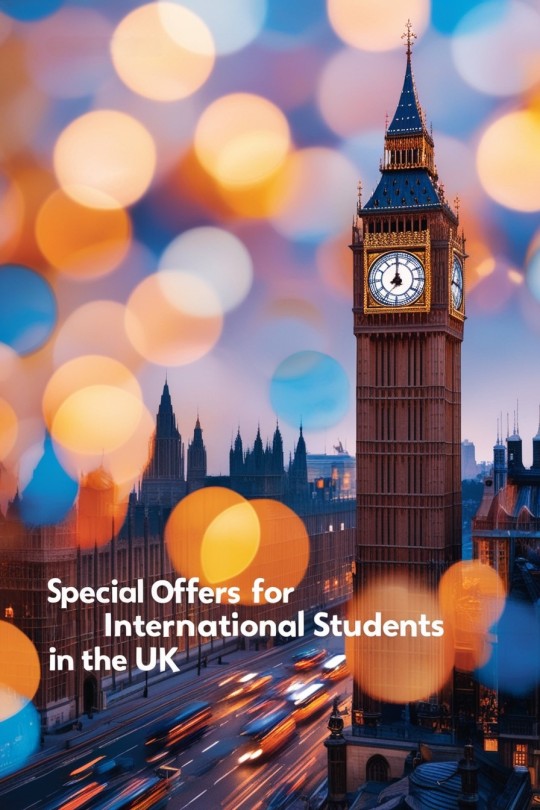
Studying in the UK as an international student has numerous advantages, particularly regarding discounts! Whether it is the groceries and utensils to be bought or to be used while travelling, there are always some student offers to make life cheaper. I found a number of shops, cafés and entertainment centres offering student discounts– all one needs is to have their ID with them.
Transportation is another area where international students save big. Discounted travel cards make exploring cities or even taking trips across the country much easier on the wallet. Need supplies for your studies? You will find it easy to Shop for textbooks, stationery, electronics and other software, at a cheaper price with quality to enable you to perform well in your academics without straining your financial muscles.
This also includes leisure with offers on membership to health clubs and classes, events and other cultural happenings. Some of these offers assist international students to have fun in the UK without putting a hole in their pockets.
Student Perks: Save on Everything!
Academic and Living Expenses
Tuition Fee Discounts: Many universities offer early payment discounts, sibling scholarships, and merit-based reductions for international students.
Accommodation Discounts: University halls and student accommodations frequently provide reduced rates for international students, with some offering first-month free or significant initial discounts.
Health and Insurance: The National Health Service (NHS) provides comprehensive healthcare access. Many universities offer additional health insurance packages at reduced rates for international students.
Transportation and Travel
16-25 Railcard: Offers 1/3 off rail travel across the UK
Student Oyster Card: Provides significant discounts on London public transportation
National Express and Megabus Student Discounts: Reduced rates for long-distance travel
Lifestyle and Entertainment
Student discounts: at restaurants, cafes, cinemas, museums
NUS (National Union of Students) Extra Card: Provides discounts across 100+ brands
Cultural venue discounts: Reduced entry to museums, theatres, and cultural events
Opportunities and Support for International Students
Professional and Career Opportunities
Post-Study Work Visa: The UK's Graduate Route allows international students to stay and work for two years after completing their degree
Internship Programs: Many universities have dedicated international student internship schemes
Networking Events: Regular career fairs and professional development workshops
Technology and Study Resources
Discounted software licenses (Microsoft, Adobe)
Free access to academic databases
Reduced-cost computer and technology purchases through university programs
Cultural Integration and Support
Free English language support classes
Cultural exchange programs
Mental health and counselling services tailored for international students
Dedicated international student support offices at universities
Your No-Stress Manual to Getting Student Housing in the UK
Finding student accommodation in the UK can seem overwhelming, but StudentTenant.com simplifies the process! It acts like a helpful guide for international students searching for ideal student rooms. Studying has never been as easy and safe as today and there is no faster way to find affordable and comfortable student accommodations.
Here, you can fine-tune your search according to your needs, see straightforward prices, and take tours without leaving your house. Looking for help with the UK’s rental laws? You’re fully covered here and you’ll get explanations without any legal jargon and your rights as a tenant are explained here as well. In addition, you can share a conversation with landlords and learn from real student testimonials.
Student Tenant is dedicated to ensuring that your search for the perfect student housing is stress-free. All you need to do is click, search and voila, the house is ready for occupancy.
0 notes
Text
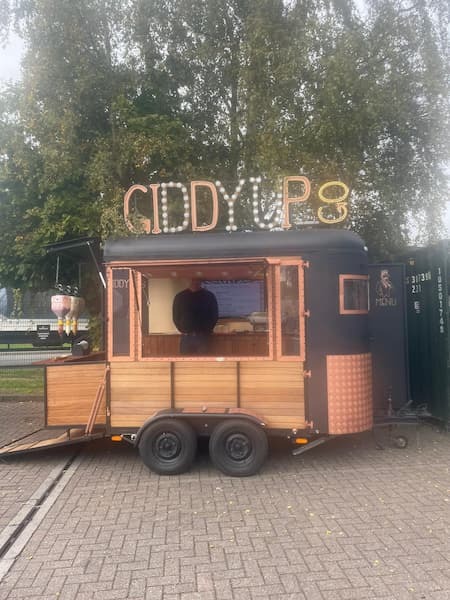
At one time mobile catering consisted of almost entirely box shaped 'burger vans'. Occasionally someone with a touch of flair, or perhaps just a bit mad, would put together something quirky. With the dawn of the instagram generation, boxy burger vans suddenly dropped out of vogue. To get ahead you really needed people to be sharing your set up. Sure, good food was important, but it was no longer the sole arbiter of success. Your food truck needed to look better. We are going to be taking a look at some of the quirky, weird, wonderful and downright strange catering outlets around the world. Happy Larrys Shipping containers are ubiquitous throughout the world. A standardised method of transporting goods via road, rail and sea. Many of them however do find a second life as something totally different. From bars, to offices to mobile toilets. They have also found favour with catering vendors. The basic container is a strong watertight structure, that is built to accurate dimensions, and lends itself to conversions. Happy as Larry is an Australian company that specialises in selling Napoli-style wood fired pizza. A nice touch in this container conversion is that they have replaced much of one side with huge glass pains to give a real contemporary feel to it. Space Shuttle Cafe If you are looking for something to convert into a food truck, the most obvious thing you could think of is an aeroplane. Probably not! This one was converted to a mobile eatery by GMC in 1976. But it started life as an actual flying machine in 1944. Cotton Candy Jeep One of our favourites this, take an iconic WWII off road vehicle, and shove a cotton candy (candy floss if you live this side of the pond) machine in the back. Oh and for good measure paint it all pink. Walls Mini Ice Cream Truck Walls ran a campaign called 'Goodbye Serious', where they built a miniaturised ice cream truck designed to drive into offices and dispense their best selling goodies. This is one seriously quirky little food truck. Though some of our taller staff might struggle to operate in this one. K99 Ice Cream Cart This one is notable, not for being a different type of food truck. But because of its target market. This sells ice creams for your canine companions. That's right, doggy ice creams. Seems that scientists have discovered that gammon and chicken-flavored ice creams really hits the spot for our doggy friends. Vintage Caravan These are gaining in popularity, and are being used for everything from a gin bar to a burger joint. The ironic thing is, was during the late 90's, the fairground industry used these for staff quarters, then tended to scrap them at the end of the season. If they were scrapped, it wasn't unknow to just remove all identifying marks and leave them in a layby for the council to dispose of. You try buying one now, I have seen them advertised for upwards of £30k. Step Frame Food Truck More of a Stateside set up, they have a plethora of large step fram delivery vehicles from the likes of Dodge, Ford, GMC etc. These are pretty near the size of a 7.5 tonne lorry in the UK and make an ideal blank canvas to fit out as a mobile eatery Airstream Style Food Truck Another option hailing from the good ole US of A. Airstreams were originally touring caravans. Till some adventurous soul decided to cut the side out and add a kitchen. They are now a fairly regular sight on the UK scene. With both the original Airstream brand and a number of both EU based and Chinese manufacturers building similar looking trucks. Converted Vintage Horsebox Stunning Horsebox Food Truck Hire A regular sight nowadays, horseboxes are easy to obtain, pretty easy to convert and very flexible, though a bit on the small side for some catering options. Prices are steadily rising, to the benefit of anyone needing to dispose of a horsebox that's past it's sell by date. What you once would have scrapped, you can now get a tidy few grand for. Snow Mobile Food Truck This one is as far as we know, pretty unique. A burrito joint on a tracked snow mobile platform. Great for last minute corporate jobs in the arctic. Bloody noisy if you need to take it down the M1 motorway to London. London Red Bus Yoghurt Truck An iconic British vehicle this time, an ex London Routemaster bus, turned into a yoghurt dispensary by Snog. A cool vehicle for a cool brand serving a cool product (literally)! The Peanut Van Occasionally there are totally custom built trucks out there. I've seen vehicles that look like hot dogs, doughnuts, oranges. This one is a peanut. Leaves you in no doubt what the product is. Land Rover Ice Cream Truck Another off road vehicle pressed into service. We have already had a Willy's Jeep with a candyfloss machine. This one is the UK equivalent. In vehicles that is, not food. This is one cool ice cream truck. Monster Truck Another ice cream van. This time shoehorned into a monster truck. Unless you are 6ft 6 you need step ladders to be served here. Rocket Launcher Coffee Truck A big boys toy this one. A coffee truck on a rocket launcher. Though it didn't work out too well for two of the staff when they were arrested for causing panic on the streets of Malaysia. What's next, doughnuts served from a Challenger tank? Tactical Tapas Another paramilitary offering. Tapas from a tactical armoured car. It's all starting to get a bit Mad Max. Fire Engine The last couple of options were built on trucks designed to blow things up and start fires. These were designed to put them out. Popular both sides of the pond, though the US fire trucks just seem to be a lot more jazzy. Read the full article
0 notes
Text
TWENTY-FOUR
Smiles in the sunshine and tears in the rain
Still take me back to where my memories remain
Flickering embers grow higher and higher
As they carry me back to the Mull of Kintyre.
PAUL MCCARTNEY & DENNY LAINE (1978)
THE ZOOLOGIST James Wilson stood on a boat not far from here one beautiful summer’s evening in 1841. It was calm. It was still. Lights gleamed along the shore, and there was ‘a peculiar concerto between sea and land’. He jotted: 'A shoal of porpoises was tumbling and blowing in the bay, while the dry monotonous craik craik of the land-rail was as distinctly heard as if we had been anchored in the middle of a clover field.'
Nikki and I are sheltering in the doorway of a disused shop in cold, wet Campbeltown. I’ve an electronic version of Wilson’s A Voyage round the coasts of Scotland and the Isles on my steamed-up phone.
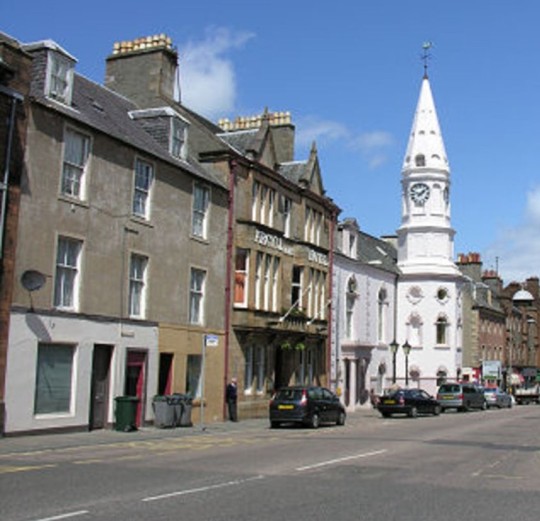
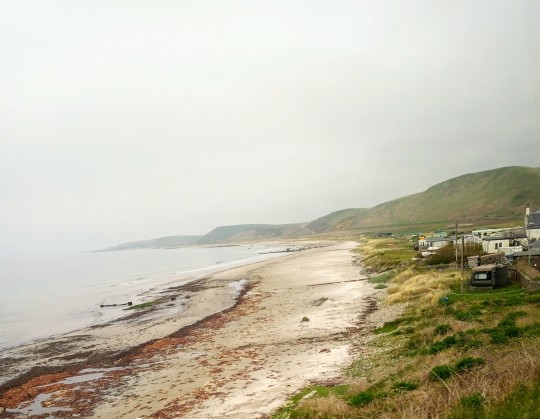
There is a shower of the kind of rain that looks less wet than it turns out to be. There are no seabirds or cetaceans in sight. It’s a damp day at the stub end of April. We are in between showers in Kintyre, that arm of land that reaches down the map to meet the ocean beyond the Mull. I have mislaid my rain-proof trousers. Had my dear father, who died while I was writing this book, been standing beside me, he’d have advised me, as he had done during a storm when I was eight: 'If it disnae kill you, it’ll cure you, boy. Your skin’s waterproof, either way.'
For some folk Kintyre may be the road to nowhere, but Scotland was more or less born here: as dreamy Dál Riata, the kingdom of the Gaels from Antrim, who settled here at the end of the fifth century. John Macculloch wrote, of Campbeltown itself (The Highlands and Western Isles of Scotland, 1824): 'A more picturesque and beautiful situation for a maritime town could not well be found, and, from different points, it presents some fine views; uniting all the confusion of town architecture with the wildness of alpine scenery, the brilliancy of a lake, and the life, and bustle, and variety, incidental to a crowded harbour and pier.'

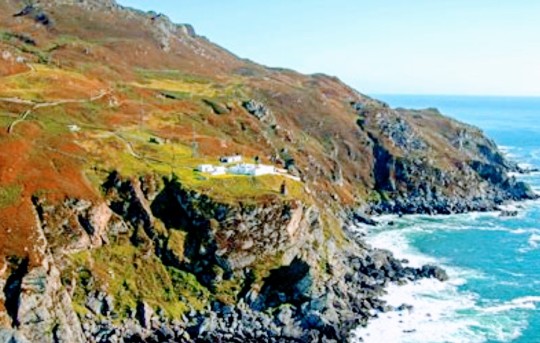
Visitors to Kintyre used to arrive by sea. Most now take that long and winding road from Glasgow to Campbeltown, but the last leg of it, down the A83 from Tarbert, is relatively straight: it edges a raised beach lashed by the Atlantic rollers of the west: a wild seaboard gashed by mini ravines that have no right to be so close to so sandy a littoral. A glacier maybe dumped them one after a jagged other to become rocky outcrops. Shards and larger boulders. Mini-pinnacles. Seabirds of several species perch out on a scar there today and I’ve counted, what, 20 cormorants. A sight to behold, as we unwind from jumping off the bus to help the driver release a lamb trapped in a fence.
Here, from the Glasgow bus, you can, in fair weather, marvel at the distant outline of the Paps of Jura undulating their strangeness out on the horizon. After a while the road turns inwards for a few miles to reach the ‘wee toon’, which is fringed by a sweeping horseshoe bay beneath hill-land. Wee Campbeltown was once the capital of the old Gaelic kingdom. At the end of the 19th century it was a boomtown – one of the richest towns per capita in the UK, and so full of distilleries that they called it Whiskyopolis.
In the game of snakes and ladders that is Scotland’s economy it wasn’t always that way. Campbeltown had been the chief town of the Lords of the Isles, and effectively the capital of Scotland before Edinburgh was thought of, although Pennant observed in 1772 that it had risen in less than 30 years from ‘a petty fishing town to its present flourishing state’:
'About the year 1744 it had only two or three small vessels belonging to the port: at present there are seventy-eight sail, from twenty to eighty tons burthen, all built for, and employed in, the herring fishery ; and about eight hundred sailors are employed to man them. This town in fact was created by the fishery.' (A Tour in Scotland, and Voyage to the Hebrides)
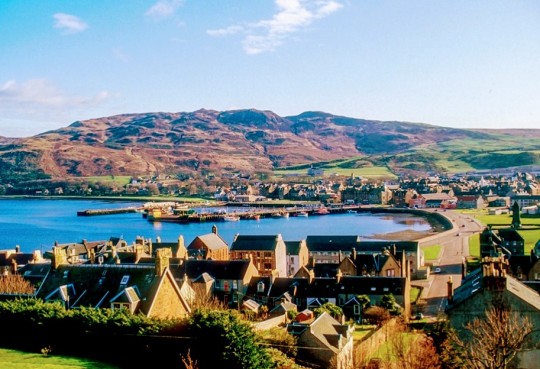

By the time the Rev. Daniel Kelly penned his entry for the New Statistical Account of Scotland in 1843, 500 families fished here but he stressed that ‘the great staple commodity of this place is the distillation of malt whisky’. There were then 25 distilleries, 76 pubs, and an Excise Office that employed 50 people.
The deep harbour was ideal for whisky to be steamed out to markets in the UK and America. Whisky tycoons built villas as grand as any erected by shipping magnates elsewhere. But the distilling industry was ultimately a victim of its success. The demand for liquor was so great that the distilleries concentrated on quantity rather than quality. The killer blow was a series of rises in spirit duties. When the 1911 census revealed an eight per cent drop in population over the past 10 years, the Argyllshire Herald declared:
'The removal from town and district of the best and most virile of our youth continues. There is but one way to stem the tide; that is, by the promotion of some new local industries.
'It remains for somebody to take the initiative, to devise new industries and so resuscitate the trade of the town, otherwise the decline will certainly continue.'
The paper noted that 37 people were emigrating every week, mainly to Canada. The distilleries began to close. There are now only three – in a town that was identified in 2013 as one of the most vulnerable in Scotland, and one of the most remote in the UK. Fuel poverty rates were nearly double the national average then. Professor Cliff Hague, chairman of the Built Environment Scotland, stated in a report: 'Like so many small towns, Campbeltown has been the plaything of forces beyond its own control. Its traditional industries – whisky, shipbuilding, fishing, forestry and tourism – have all experienced restructuring, and the same is true for agriculture which was once the mainstay of the surrounding area.'
There are encouraging signs. Glen Scotia Distillery’s 25-year-old malt has been crowned the world’s best. In the 2021 SURF awards for best practice in regeneration, Campbeltown was judged to be ‘Scotland’s most improved place’ (As many as 40 industrial buildings had received investment that totalled £13 million).
In 2023 plans were lodged for a ‘net zero’ distillery in the erstwhile whisky capital. The Brave New Spirits brand will be distilled at Witchburn Distillery in the former RAF Machrihanish airbase, which the community bought for £1. Their target is two million litres of alcohol per year, powered by 100% renewable energy and heat and energy recovery systems. The former NATO base operated as an airfield for nuclear-armed V-Bombers, for maritime aircraft hunting Russian submarines in the North Atlantic, and during the testing of Concorde.
The local populace, moreover, successfully fought plans to convert Scotland’s oldest atmospheric cinema, Campbeltown Picture House, into flats. It opened its doors the year before a young Charlie Chaplin signed for Pinewood Studios. It is still showing flicks.
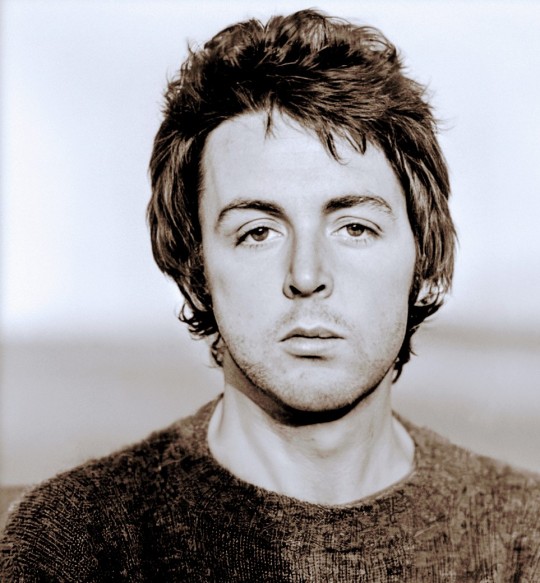
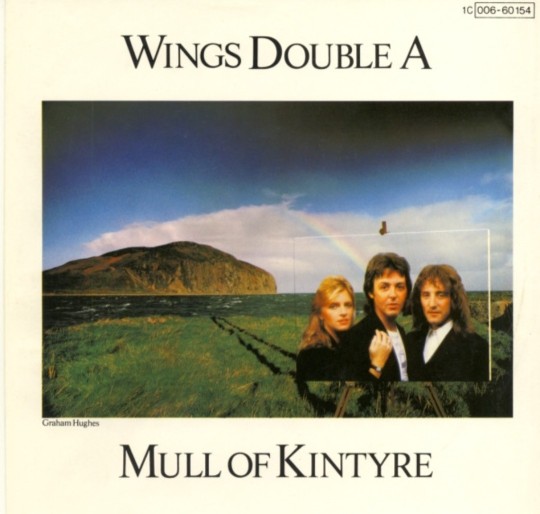
Paul McCartney’s association with Kintyre is well documented. In 1966 he asked his accountant to find him a hideaway from the world of autograph-hunters and Beatlemania. He came up with High Park, an isolated farm on the moors near the Mull of Kintyre, which became the subject of one of the best-selling songs of all time in Britain. Very few people visited the Beatle in his far-flung bolthole. But Peter Brown, who was best man at John Lennon’s wedding, revealed in his biography of The Beatles, The Love You Make (2002):
'Paul summoned Alistair [Taylor, his office manager] to High Park so that he could pay a visit to the local pharmacy for him. According to Alistair, Paul had the crabs and needed a pesticide to shampoo with.
'Being Paul McCartney, the neighbourhood celebrity, Paul was too embarrassed to ask the pharmacist in the small town for the pesticide himself, so he sent Alistair. There was also a sense of urgency to this mission, lest Paul give the tiny parasites to Jane [Asher], who would most certainly realize he had been unfaithful to her.
'The town pharmacist was baffled by Alistair’s request. He had nothing for that purpose other than "sheep dip", which was used to delouse cattle. Paul presumably made do with that.'
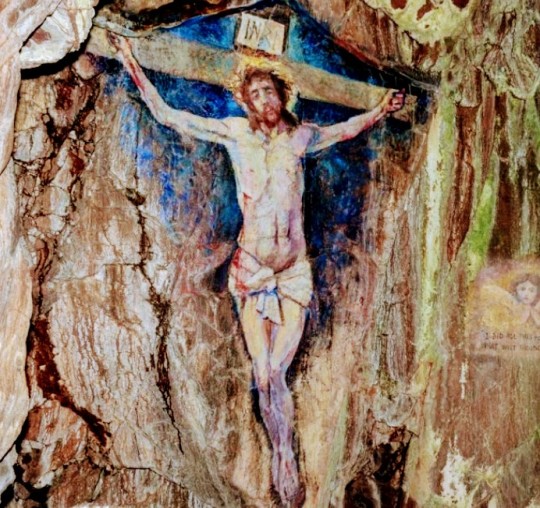
In August, 1887 an unnamed boater rowed ashore in Campbeltown loch to stretch his legs. He wandered into one of the seven caves that notch the south of Davaar island, struck a match to light his pipe – and fainted. The following day hundreds of townspeople ran along the shingle causeway to the island brandishing byre lamps and candles. There in the cave was a life-size mural of Christ on the Cross. The Campbeltown Courier informed its readers:
'Nothing could be more suitable for the contemplation of such a subject than the semi-darkness and rocky grandeur of the large cavern in which the picture is placed.'
An embarrassed local art teacher, Archibald Mackinnon, owned up to being the creator of the fresco.
Locals said Mackinnon, who attached a brush to his walking stick to paint the high features in the cave, fearing the consequences of having used the school’s raw materials to paint the mural, did a moonlight flit soon after press coverage. He turned up in Grantham, where he became an itinerant artist. There are reports that he used hair from his nagging wife’s head to make brushes. Journalists reported his subsequent return to touch the mural up in 1934 – a visit that featured in cinema newsreels. He died the following year, aged 85.
Davaar’s second claim to fame is that the island appears on the Mull of Kintyre album cover, and many latter-day seekers of weirdness visit Davaar, which is accessible along a shingle causeway at low tide. The walk takes about 40 minutes. The island, home to peregrine falcons, dolphins, basking sharks, otters and seals, is privately owned and is part of an organic working farm with holiday cottages. One pilgrim visited in 2006 with a can of red spray paint and stencilled an image of the revolutionary Ché Guevara over the painting of Christ. His identity remains a mystery, but his work was short-lived.
Along the jagged shore opposite Davaar, ‘coasters’ used to roam and squat, away from it all. Jamie ‘Loafs’ Moran, Jock Smith, and Teddy Lafferty often crashed out in a written-off ambulance; and the four Morrans brothers, Joe, Dan, Mickey and Archie, used to sleep in a converted Co-op grocery van. In search of worldly contentment they wandered through land that featured evocative names: Ru Stafnish, Johnston’s Point, Second Waters, Polliwilline Bay, Gartnagerach, and a hill called The Bastard. Journalist Freddy Gillies told the Coast Scottish heritage website: 'To aver that the coasters "roughed it"would be an understatement, but they were a breed set apart who found true happiness during their forays, either alone with their thoughts or in company, particularly in the surroundings of the Learside’s coarse grass and pebble-strewn beaches.
'Sustenance came in the form of dry or tinned stores, occasionally supplemented by rabbit stew or "wilk bree", a thin soup made from periwinkles. Tea, naturally, was taken regularly, as were certain stronger brews.'
For holidaying motorists a 66-mile circular road trip, Kintyre 66, was launched in 2021. From Campbeltown it snakes its scenic way up the east coast via the B842 to Skipness and Claonaig, one of the ferry points to Arran. On its way up the Kilbrannan Sound the route doesn’t veer too far from the coast. There are some stunning views of the Arran skyline from this narrow highway. The road is a single-track one for its last 18 miles.
En route, eight miles north of Campbeltown, lies Saddell Bay, along which a pipe band marched in a memorable video that promoted Wings’s hit single.
Kintyre, of course, has a long history of music-making, on top of McCartney and the ‘Campbeltown Loch I wish you were whisky’ that Andy Stewart once belted out. From his home in the south of England the Rev. Edward Bradley visited Kintyre most summers and he wrote books about its folklore, under the pseudonym, Cuthbert Bede. One of them was Argyll’s Highlands or MacCailein Mor and the Lords of Lorne, published posthumously in 1902, three decades after his research. In the preface John Mackay, the editor of Celtic Monthly, argued: 'It has been left to "outsiders" to produce the best books on Kintyre. Cuthbert Bede ….. has, by implication, shown what a native might do, if he only took the trouble to even note down the ceilidh stories which he heard told round the winter fire.'
Bede wrote warmly of pedlars, vagrants and assorted travellers doing their bit to keep the old Gaelic tales going by narrating them or singing them in the vernacular:
'The shining rafters of the peat-reeked roofs would vibrate to the reels and jigs and strathspeys danced by the barefooted lads and lassies on the earthen floor to the inspiring music that the beggar with the Jew’s harp blew from his pipes, or scraped out of his fiddle, or breathed from his Lochaber trumps.
“Then, tired from jigging, they would gather around the fire and listen to the beggar recite the mystical poems of Ossian. The beggar would relate wild legends and thrill them with stories of ghosts and warlocks and brownies and water-kelpies, told with dramatic power and an actor’s art.'
Bede added: 'Such wanderers as these were wondrous popular in the Western Highlands and Islands, and nowhere more so than in Cantire, where, at its veritable Land’s-end, the Mull was more thickly populated than it is in these sheep-farming days.'
A lady in white and a sinister monk are the resident ghosts of Saddell Castle near the aforementioned bay of the same name. Bede observed in the 1870s that it was one of only two castles in Kintyre in a reasonable state of repair, the other being Skipness further up the peninsula. In 1976, the Landmark Trust restored it to its former glory.
After a basking shark made a boat capsize in the Kilbrannon Sound in 1937 – killing three people – a shark processing factory was established at Carradale almost in revenge. The oil was used for Tilley lamps and candles.
A piece in The Scotsman in June 1939 tells of crowds gathering on Carradale Pier to watch sharks being harpooned. As soon as the harpoon was fired, the sharks dived and disappeared, but one was hit and it ‘made off at racing speed towards the Kilbrannan Sound but whirled back in its tracks and went round and round in the bay in a series of great circles’ towing the boat with it.
Not far away, in 2022, an Israeli arms company, Elbit Systems, appeared overnight in a car park nearby to erect masts! Niall Macalister Hall, who owns the Torrisdale Castle estate, told the Daily Record:
'They were pretty arrogant and said they didn’t need permission to do anything. They design and operate drones and they are into weapons systems, so we’re naturally wanting to know what they are up to.'
Elbit Systems UK employs 600 people over 13 sites, many of which have been targeted by protestors from the Palestine Action group.
The novelist and socialist activist Naomi Mitchison lived in Carradale for many years, and Flora Drummond, the Arran-born suffragette ‘general’, who was one of the pall bearers at Emiline Pankhurst’s funeral, lived her final years at Carradale, almost opposite her childhood home in Arran. She is buried in the village cemetery. Drummond was jailed nine times and undertook hunger strikes to advance the cause.
Possibly the highlight of the eastern flank of Kintyre is Skipness. Skipness estate was once run by stereotypical gung-ho gentry. The shooting extended over 20,000 acres, and visitors could bag grouse, black game, partridges, hares, rabbits, wood-cock, snipe, plover, pheasants and roebuck.
Colonel Walter Campbell, the so-called ‘Old Forest Ranger’, owned Skipness when he wrote his Indian Journal in 1864. Campbell revealed that when he returned from the colonies, his tutor, the foxhunter Alan McIntyre was still creeping about with his long-barrelled gun under his arm in his 70s. Campbell reminisced:
'It was really affecting to see the poor old man with tears of joy pouring over his furrowed cheeks, as I displayed to him my Indian trophies of the chase, and reminded him that, but for his good training I should never have earned them.
'He patted me on the back, calling me "the calf of his heart", the pride of his old age, and would sit for hours gazing at the heads and skins which decorated the hall, as an old Indian chief might do upon the scalps taken in war by his only son, chanting the while a song of triumph which he had composed on my return from "the far-off hunting-grounds near the rising sun", where I had slain great wild cats larger and stronger than a Highland bull.'
In his 1853 book, The Old Forest Ranger: Or, Wild Sports Of India On The Neilgherry Hills, In The Jungles, And On The Plains, he had written longingly about spearing wild boar watched by ‘vulgar Hindoos’. That’s probably enough of Campbell.
#campbeltown#davaar#mull of kintyre#skipness#kintyre#whisky#distilleries#paul mccartney#saddell#naomi mitchison#suffragette
0 notes